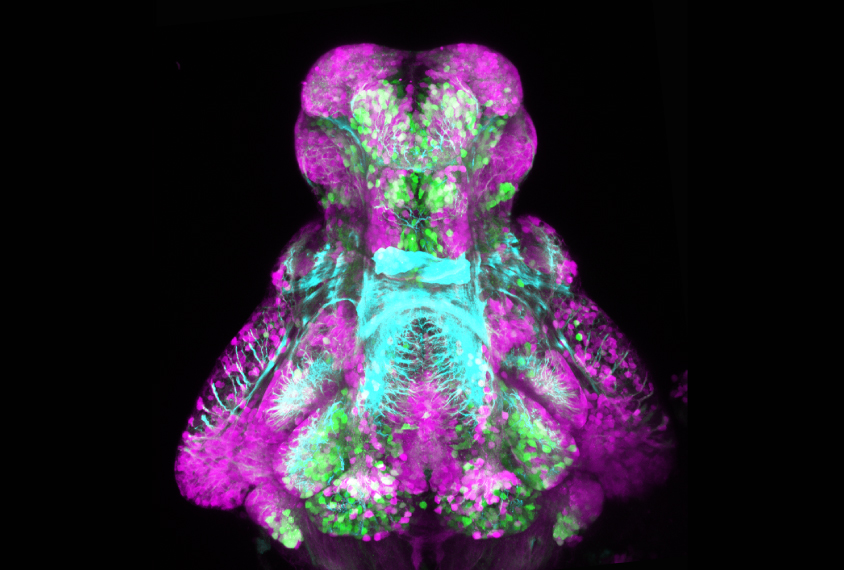
Kate Turner
THIS ARTICLE IS MORE THAN FIVE YEARS OLD
This article is more than five years old. Autism research — and science in general — is constantly evolving, so older articles may contain information or theories that have been reevaluated since their original publication date.
Editor’s Note
This article was originally published 16 May 2015, based on preliminary data presented at the 2015 International Meeting for Autism Research in Salt Lake City, Utah. We have updated the article following publication of the study 28 January in Neuron1. Updates appear below in brackets.
A drug that mimics estrogen eases hyperactivity in zebrafish embryos lacking the autism-linked gene CNTNAP2. The results highlight the enormous potential of the tiny fish for studying autism.
“People ask me, ‘What does a zebrafish with autism look like?’ I don’t know and that’s not the point of the research,” says Ellen Hoffman, associate research scientist at Yale University, who presented the preliminary results at the 2015 International Meeting for Autism Research in Salt Lake City, Utah,. “The point is to go from genes to mechanisms in a simple, tractable system,” she says. “Zebrafish are a jumping-off point.”
New gene-editing technologies have made it relatively easy to insert mutations into these fish. Researchers can then use basic zebrafish behaviors to assess the effects of the mutations.
In the study, Hoffman, who did the work as a graduate student, looked at the activity levels of hundreds of zebrafish embryos over a three-day period. The fish are normally docile at night, but those lacking CNTNAP2 swim excitedly.
This behavior suggests that their brains have too many excitatory signals compared with those that dampen neural activity. This same sort of signaling imbalance is implicated in both autism and epilepsy.
In line with this, a closer look at the brains of the mutant zebrafish embryos revealed a 35 percent decrease in inhibitory neurons compared with normal zebrafish. [The fish are also hypersensitive to a drug that induces seizures by decreasing inhibitory brain activity.]
The researchers teamed up with Jason Rihel, a researcher at University College London, who had mapped the effects of 550 drug compounds on zebrafish activity.
They used these data to look for drugs that make the normal fish look either like the mutants (active at night) or the opposite (more active during the day and less so at night).
Drugs that make normal fish hyperactive at night may hint at the pathways that are abnormal in the CNTNAP2 mutants. [Drugs that specifically dampen either excitatory or inhibitory brain signals make typical fish behave like the mutants, the researchers found.]
Conversely, those that make the normal fish especially active during the daytime and less so at night might be good candidates for treating the mutant fish.
Surprisingly, of the top 10 drugs that had this latter effect, 4 turned out to act on the estrogen system. When the researchers tested the drugs on the mutant fish, they found that one, Biochanin A, is the most effective at easing nighttime hyperactivity at the lowest concentrations. [Beta-estradiol also eases nighttime hyperactivity in the mutant fish.]
How this compound works is unclear, but Hoffman says she has preliminary evidence that it may affect inhibitory signals in the brain. “Biochanin A highlights a pathway that we should investigate further in rodent models,” Hoffman says.
[To pin down which circuits may be altered in the mutant fish, Rihel and his team are engineering fish that carry an indicator in certain neurons that glows when the neurons fire. The larvae have transparent brains, allowing the researchers to watch as these neurons light up in awake, behaving animals. “Maybe there’s a circuit that starts going crazy in the middle of the night in the mutants,” says Rihel.
The researchers also tested the effect of the antipsychotic risperidone, one of only two drugs approved by the U.S. Food and Drug Administration for children with autism. Risperidone decreases nighttime hyperactivity in the mutant fish. But unlike Biochanin A, it also sedates the fish during the day.
At low doses, Biochanin A alters behavior only in mutant fish, suggesting it acts specifically on the disrupted pathway. Risperidone’s effects seem to be less specific, as it alters behavior in normal fish as well at all doses.
To further explore Biochanin A as a treatment for autism, Rihel aims to test it in mice lacking the CNTNAP2 gene. These mice are hyperactive during the day, when mice normally rest, suggesting that the mutation affects the sleep and rest cycle. If this proves to be true, drugs such as Biochanin A might treat the sleep problems commonly seen in autism, Rihel says.
The fact that 4 out of 10 promising drugs affect the estrogen system seems to suggest that elevated estrogen could contribute to a ‘female protective effect’ that guards girls and women against autism. But the zebrafish larvae in the study haven’t even developed gender yet, cautions Rihel. “I think it’s an intriguing link and maybe there’s something there,” he says. “But it may be spurious.”]
The researchers aim to extend this work to as many autism mutations as possible. They have already generated zebrafish lacking other genes linked to autism, including CHD8, SCN2A, DYRK1A and GRIN2B. Together, the findings could help researchers home in on pathways commonly affected in autism.
By joining the discussion, you agree to our privacy policy.